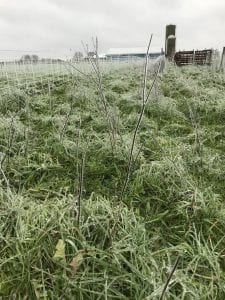Christine Gelley, OSU Extension Educator ANR, Noble County
(Previously published on Farm Progress – Ohio Farmer: April 17, 2024)
Sticks help determine an estimate of available forage dry matter per grazing paddock.
help determine an estimate of available forage dry matter per grazing paddock.
Measuring the amount of forage available for livestock to graze is a helpful task for designing and adjusting pasture rotations for grazing livestock.
There are many potential methods for measuring the amount of forage mass growing in a pasture. All of them require time spent in the pasture and repetitious measurements to develop estimations of whole pasture forage availability.
One of the simplest methods for estimating forage availability is using a grazing stick.
What does the grazing stick do?
A grazing stick combines information about forage height, forage density, species of forages growing in the pasture and residual grazing heights into a tool that looks like a yardstick. Continue reading

 is coming to an end, and much faster than in normal years.
is coming to an end, and much faster than in normal years. of the most beautiful and luscious plants can have deadly consequences for our livestock. These are the plant toxicities seen most commonly in livestock in our area:
of the most beautiful and luscious plants can have deadly consequences for our livestock. These are the plant toxicities seen most commonly in livestock in our area: and goat operations all experience some amount of hay waste during winter feeding. Now is a good time to look back and evaluate how much hay was wasted.
and goat operations all experience some amount of hay waste during winter feeding. Now is a good time to look back and evaluate how much hay was wasted.

 snow, ice, and freezing temperatures are on the way. Winter can be a real struggle for two- or four-legged animals. Those of us with two legs can generally put on a warmer coat or go inside to warm up with a cup of something hot, but what can livestock managers do to keep animals healthy and comfortable in the upcoming winter? Being proactive about livestock’s winter needs will reap many more dividends than will responding to a problem after it has developed.
snow, ice, and freezing temperatures are on the way. Winter can be a real struggle for two- or four-legged animals. Those of us with two legs can generally put on a warmer coat or go inside to warm up with a cup of something hot, but what can livestock managers do to keep animals healthy and comfortable in the upcoming winter? Being proactive about livestock’s winter needs will reap many more dividends than will responding to a problem after it has developed.
